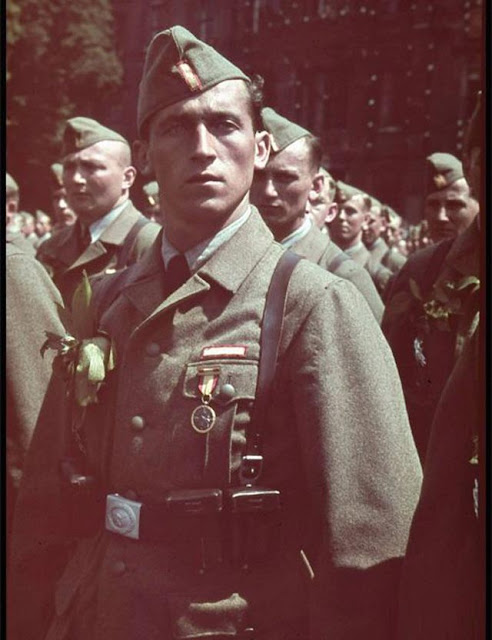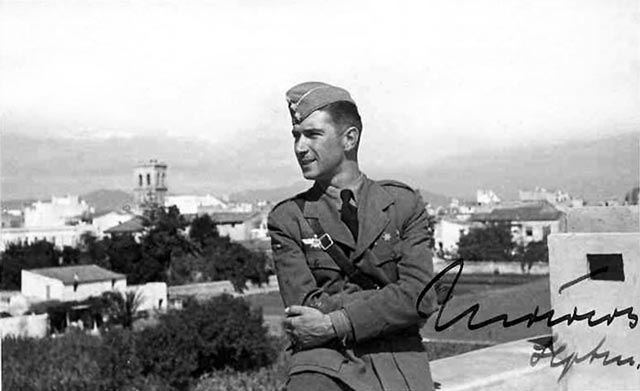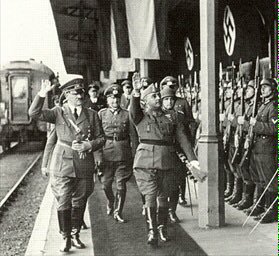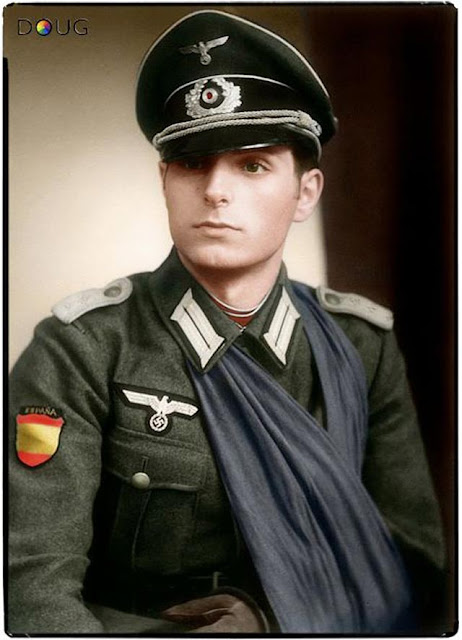The Spanish Blue Division Fought For Hitler
The Spanish forces serving with Germany in World War II have been the subject of myths and legends ever since their formation. Some people want to disparage them as simply fascists sent to do their dictator’s bidding, while others place them in the highest esteem as elite troops teaching the Wehrmacht a lesson or two. Let’s sort this out and see what they actually were all about.
 |
| Members of the Condor Legion. |
Germany Helped Franco's Forces Win the Spanish Civil War
The topic of German involvement in the Spanish Civil War is huge and I at some point will give it a separate article. However, it is important to run through the basics because they serve as the foundation for Spanish assistance to the Reich during World War II.General Francisco Franco was influential in Spain prior to the civil war because he was a former director of the military academy. He also used extreme force including artillery and bombing raids to put down a miner's strike in the Asturia region in 1934. So, Franco was known as a tough general but was not the instigator of the 1936 coup. In fact, Franco had no special relationship with the coup plotters and appeared willing to join the Loyalists, also known as the Republican or the government party, if given the right command. He equivocated over which side to support for some time. Franco was assigned a command in Africa, where the coup originated.
 |
| Members of the Condor Legion setting off for Spain. |
The important point is that Franco had no particular hatred of Britain or the Soviet Union. A curious fact is that two British Secret Intelligence Service pilots, Cecil Bebb and Hugh Pollard, flew Franco in a chartered Dragon Rapide aircraft from the Canary Islands to his command in Spanish Morocco on 18 July 1936. Franco was less an ideologue than an opportunist
 |
| Members of the Condor Legion were in Spain to fight. |
In Spain, Romanian volunteers led by deputy-leader of the Iron Guard ("Legion of the Archangel Michael") Ion Moța fought with Franco. They were joined by an "Irish Brigade" led by Eoin O'Duffy. Italy sent the Aviazione Legionaria and the Corpo Truppe Volontarie along with 660 planes, 150 tanks, 800 artillery pieces, 10,000 machine guns, and 240,000 rifles. The Royal Italian Navy (Regia Marina) blockaded Mediterranean ports on behalf of Franco. None of these countries declared war, they were completely "neutral."
On the other side, "International Brigades" formed that represented 53 nations. Joseph Stalin used his contacts around the world to organize the "volunteers" to these brigades, who often were communists trying to ingratiate themselves with the font of world communism. Unlike the Nationalist legions and brigades, these Republican formations were more unofficial as representatives of their governments. These volunteers included 10,000 men from France and smaller numbers from the Soviet Union, the United States, the United Kingdom, Austria, Poland, Yugoslavia, Hungary, and Canada, among others. Curiously, there also were about 5,000 men from Germany serving in the International Brigades.
 |
| German military equipment at the time of the Spanish Civil War was still rudimentary, such as this Panzer I. |
As a result, Hitler sent to Spain the Condor Legion, a unit composed of volunteers from the Luftwaffe and the German Army (Heer) from July 1936 to March 1939. These troops proved critical early in the Spanish Civil War, particularly at the 1936 Battle of Toledo. Germany helped move Franco's troops from Africa to Spain, a critical event that supposedly put Franco in Hitler's debt.
 |
| The top Luftwaffe aces of World War II such as Adolf Galland and Werner Molders (shown in Spain) got their training during the Spanish Civil War. |
Germany provided Franco with massive financial support, roughly £43,000,000 ($215,000,000) in 1939 prices. Hitler sent 600 planes and 200 tanks and the German Condor Legion suffered about 300 killed. The Germans provided critical help to Franco at key junctures, such as the reconquest of Teruel. With Spain devastated, Hitler leaned on Franco for some kind of repayment, so Franco gave the Reich access to Spain's mining resources. This led to a situation where Hiter felt that he had created the conditions for Franco's victory, while Franco was a little less grateful than Hitler would have wished.
Hitler and Franco at Hendaye on 23 October 1940.
|
Hitler Meets Franco at Hendaye
Franco knew that his biggest international supporters were Germany and Italy. He was drawn into their orbit not only because of that but also because he distrusted France and wished to make them think they might be biting off more than they could chew if they attempted to sabotage his regime. |
| Franco was a key player in Hitler's war of conquest - if he wanted to be. |
Thus, Hitler began a campaign to convince Franco to either join the Spanish war effort or at least support the passage of German troops through the country to take Gibraltar. While this mostly took the form of exchanges of letters between the two dictators and discussions by their top underlings in Madrid and Berlin, there was one pivotal meeting at the Spanish border.
 |
| Franco and Serrano Suñer (extreme right) with Heinrich Himmler, Karl Wolff, Joachim Peiper (between Himmler and Wolff) and other top German leaders at Hendaye on 23 October 1940 (Federal Archive Bild 183-L15327). |
It became clear that Franco was not interested in entering into another war so soon after gaining power. However, for what it was worth, he reaffirmed that he was strongly pro-Axis and did promise to enter the war at some point if his numerous and onerous conditions were met.
 |
| Spain controlled access to the massive British base at Gibraltar, but Franco controlled Spain - and he did not want to go to war. |
 |
| Franco supported Hitler - up to a point. |
Peak Support: Franco Sends Troops to the Eastern Front
In essence, Franco played a double game throughout World War II. He paid lip service to the Axis cause but also maintained secret contact with the British - who, as noted above, also had helped him at critical moments during the Spanish Civil War. In some ways, Spain's position was similar to Turkey's at the other end of the Mediterranean. Both countries gave tantalizing hope to both sides that they would join them, but ultimately never did.Franco did more than just pay lip service to his support for the Axis. He helped the Germans in small, inconspicuous ways. For instance, Franco allowed German ships to use Spanish harbors, even though that technically was illegal as a neutral country. His biggest expression of actual support for the Reich was sending 14,000 troops to the Eastern Front shortly after the German invasion (Operation Barbarossa). This was the famous "Blue Division," designated by the Wehrmacht as the 250th Infantry Division.
Persistent German demands that Spain should assist the effort against communism led to Súñer's suggestion that Spain could send a volunteer formation to help the Wehrmacht in the Soviet Union, just as Germany had sent the "volunteer" Condor Legion during the Spanish Civil War. Hitler, taking what he could get, approved this suggestion on 24 June 1941. Franco's reason for contributing troops may have been partly motivated by a desire to share in the spoils of a campaign that everyone at the time felt would be quick and easy. This was a common feature of the 1930s and 1940s when countries such as Italy, Romania, Finland, and Hungary eagerly joined or supported Hitler's adventures in the belief that victory was assured.
 |
| General Agustín Muñoz Grandes. |
 |
| A member of the Spanish Blue Division on the Eastern Front, dressed in a Wehrmacht uniform with the distinctive Spanish patch on his right sleeve (colorized). |
Franco voiced great support for the Axis as his troops were on the trains heading to Austria. On 17 July 1941, the fifth anniversary of the "National Uprising" (Alzamiento Nacional), Francisco Franco gave a speech to his fascist party's National Council in Madrid. It was perhaps his most bellicose speech of World War II, and it surprised a lot of people, including his own Foreign Minister (and brother-in-law), Serrano Suner.
Everybody in the diplomatic corps was present for the afternoon speech, including the United States ambassador, Alexander W. Weddell. Nobody really expected anything special, which made the shock all the greater. Franco makes clear his belief that the Reich was on the march to victory, accuses the British of maintaining an "inhuman blockade of a continent," excoriated the U.S. for not selling food to Spain (a claim of dubious truthfulness), and warned the United States against getting involved in the European conflict:
No one is more authorized than ourselves to say that Europe has no ambition in America. A contest between the two continents is an impossible thing. It would mean only a long war at sea without results; fabulous business for a few and unsuspected miseries for many; prodigious losses of ships and goods; a war of submarines and high-speed vessels striking blows at the hitherto peaceful commerce of the world.Franco then went further and added that "the American coasts are in danger from the attacks of the European powers." He concluded:
The war was badly planned and the Allies have lost it... What is proposed is a new between the continents which by prolonging their agony will give them an appearance of life and in the face of this we who love America feel the anxiety of the moment and pray that the evil of which we have a foreboding may not reach them.Exactly what Franco intended to accomplish with this speech was unclear. However, as was his customary practice, he gave no indication that he was about to declare war on anybody. In light of the pro-German tone of the speech, it can be viewed as a continuation of his strategy of placating Hitler while keeping his own distance from the war itself.
The Blue Division at War
The Wehrmacht formally incorporated the Blue Division into its organization table on 31 July 1941 as the 250th Infantry Division (62nd, 263rd, and 269th Infantry Regiments) when they take the standard loyalty oath to Hitler. Initially assigned to Army Group Center, the Spanish troops are rerouted at Vitebsk on 26 September 1941 to Army Group North. There, they are to become part of the German 16th Army.The Blue Division's first deployment was on the Volkhov River. Its headquarters was at Grigorovo, near Novgorod. It was assigned a relatively large portion of the Volkhov River line, 50 km, south of Novgorod. They provided support in the abortive advance to Tikhvin, which was briefly captured and then relinquished by the Wehrmacht in late 1941. Stalin considered this the first major Soviet victory of the war.
After the Tikhvin operation, the section of the Volkhov line held by the Blue Division was relatively quiet despite large battles to the north and south. In August 1942, the Soviets mounted a major attempt to relieve the siege of Leningrad which the Germans had difficulty resisting, so the Blue Division was moved north to a position just south of the Neva near Pushkin, Kolpino and Krasny Bor in the Izhora River area. This again turned into a very stable position.
General Emilio Esteban Infantes took command of the Blue Division from Muñoz Grandes in December 1942. Infantes owed his position to friendship with the Spanish Minister of War, General José Enrique Varela. In a somewhat odd event, Hitler personally administered the military oath to Infantes at the Berghof and inducted him into the Wehrmacht with the rank of Generalmajor.
Infantes proved to be a capable officer despite German suspicions that he was a lukewarm supporter of the Axis. His troops helped to contain another Soviet attempt to relieve Leningrad in February 1943. The Blue Division fought well and took heavy casualties against the Soviet 55th Army at the Battle of Krasny Bor. This proved Infantes' credentials and was probably the most significant contribution by the Blue Division during the war. The Germans promoted Infante to Generalleutnant and awarded him the German Gold Cross and, on 3 October 1943, the Knight's Cross of the Iron Cross.
The Blue Division Ends
By late 1943, Franco had lost the martial spirit on behalf of the Axis cause that he had professed so heatedly in July 1941. Shortly after Infante's promotion in the first half of October 1943, Franco decided to recall the Blue Division. The Germans were outraged, and to mollify them, Franco agreed to substitute a token 1,000-man "Spanish Legion."By this point, Franco was looking over his shoulder at the Allies, who were putting pressure on him to abandon Hitler. Rather than send picked troops with the Legion, Franco stacked it with Loyalists who secretly supported the Soviet Union and not only had no desire to fight but often looked for the first good opportunity to defect. This unit also was assigned to the Leningrad front performed poorly at the front, so it was soon placed in reserve.
Finally, on 10 March 1944, Franco had Infante and the Spanish military attache visit German General Walter Model at Army Group North headquarters. They told Model that Franco had ordered the Legion home to Spain. Franco, they said, needed his "matadors" home to resist a possible invasion. Thus, the Spanish troops avoided the final year of the war and all of its calamities for the Wehrmacht.
Conclusion
The Spanish Blue Division performed well on the Eastern Front. It earned its reputation for bravery, taking casualties of 4954 men killed and 8700 wounded. The Soviets also took 372 Spanish troops as prisoners (some served in the special unit Spanische-Freiwilligen Kompanie der SS 101). A total of 286 of these prisoners remained in the Soviet Union as prisoners and forced labor until finally being returned to Spain on 2 April 1954 - long after the Western Allies had released the vast majority of their German prisoners. The International Red Cross arranged their repatriation aboard the ship Semiramis.Hitler was recorded (in his late-night "table talks") as calling the Spanish Blue Division "equal to the best German ones." He said:
To troops, the Spaniards are a crew of ragamuffins. They regard a rifle as an instrument that should not be cleaned under any pretext. Their sentries exist only in principle. They don't take up their posts, or, if they do take them up, they do so in their sleep. When the Russians arrive, the natives have to wake them up. But the Spaniards have never yielded an inch of ground. One can't imagine more fearless fellows. They scarcely take cover. They flout death. I know, in any case, that our men are always glad to have Spaniards as neighbors in their sector.The Blue Division remained the core of the Spanish military long after World War II. On 23 February 1981, its former members led an unsuccessful coup against the Spanish government. These included generals Alfonso Armada and Jaime Milans del Bosch. However, this coup was defeated by other former members of the Blue Division who remained loyal to King Juan Carlos I. Thus, the impact of the Spanish Blue Division far outlived World War II.
Franco was shrewd in not throwing in completely with Hitler. However, Hitler had helped him, and there was always the possibility that the Germans could invade Spain. So, he walked a fine line, did for the Reich exactly what it had done for him, did it in an arguably legal fashion, and mollified Hitler while still maintaining neutrality that the Allies respected. It was a successful strategy regardless of what you or I may think of its morality.
2020










No comments:
Post a Comment